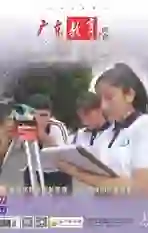运用ESA理论二次开发高中英语听说课
2019-12-30陈立
陈立

ESA教学由英国英语教育专家Jeremy Harmer(2005)提出,指的是课堂语言教学的三个基本要素,即参与、学习和激活。“参与”指引导学生参与不同的语言活动,如游戏、音乐、讨论、戏剧等。“学习”指让学生通过课堂活动和练习掌握语音知识,如发音、语法和词汇。“激活”意味着学生可以通过练习和课堂活动自由而实际地使用语言。Harmer认为,无论教授什么内容,教学中应该有这三个要素,但它们的顺序可以灵活控制。在此基础上,他提出了三种不同的教学模式,即:直线型、反弹型和杂拼型。
为了实施ESA理论并提高听说课程的有效性,笔者选择了人教版教材Book 7 Unit 1 “Living Well”的Using Language作為教学研究课。本节课的听力材料讲述了一位盲人和同伴一起攀登珠穆朗玛峰的故事,主要训练学生抓取信息的能力。
笔者对实验的班级进行分组。52名B班学生被确定为实验组,A班50名学生属于对照组。两组在年龄和表现方面没有显著差异,具有可比性。笔者根据书本的教学流程对对照组进行教学,然后根据ESA理论对实验组开展了听说教学。
一、投入阶段(Engage)
1. 设计第一次教学实践的第一稿
在开发之前,根据教科书的原始设计进行warm up.
(1)Greetings
(2)Discuss these questions in pairs: What kind of difficulty do you think weak-sighted or blind people would have climbing a mountain?Make a list.
这种warm up比较传统,并不能真正引导学生进入主题,也缺乏了语言语境材料的真实性。因此,笔者使用ESA理论重新创建。
2. 二次开发后的导入部分
(1)Show a photo of Teachers kid, whose birthday is coming.
(2)Let the students enjoy a speech by Stacey Kramer.
(3)Introduce Emily to the students and set the main task in this lesson: whether Emily also considers her disability as a gift.
笔者首先展示自己的小孩照片,说他的生日快到了,学生自然联想到礼物(为全文感情主线),接着播放一个视频,Stacey把肿瘤看成是上天赐予的礼物,让她有更积极更坚强的生活态度。然后笔者把听力文本中的男生Barry Minto改成女生Emily(为后面扮演Emily给学生做采访做准备),引出本节课的任务。
二、学习阶段(Study)
1. 第一次教学实践
⑴ Barry Minto has just made a successful climb of Mount Kilimanjaro in Africa.
Listen to him being interviewed on the radio and write down why Barry and his team did the climb and why Joan,the interviewer,describes Barrys plan for next climbing as“amazing”.
Barry and his team wanted to
Joan thinks Barrys plan is amazing because _________________________
⑵Listen again and complete the notes below:
实践后发现,学生普遍对第一步的听力练习感到吃力,全班的答对率仅为55.4%。第二步的单纯获取信息不能促进师生互动,语言的交际性原则也没有体现,全班获取信息的正确率只有66.8%。第三步的操作不能引发学生的积极讨论。
2. 大范围修改教学设计初稿
Step I Listening(A self-introduction of Emily)
1)Guide students to predict the topics to be mentioned in the self-introduction.
2)Guide students through the skills of listening for key information and guide them to pay attention to the language signals and discourse markers.
3)Play the record twice with different focuses.
4)Check the answers and introduce the function of language signals and discourse markers.
Step II Speaking(An interview with Emily)
1)Guide the students to put forward correct questions based on the notes on the learners sheet.
2)Guide the students to prepare some functional items of expressing wishes and congratulations.
3)Teacher plays the role of Emily and answers the questions given by the students.
4)Check the answers.
Step Ⅲ Speaking(Opening questions)
Guide the students to discuss:
1) Does Emily consider her disease a gift? Whats your reason?
2) What can we learn from her?
这个部分对教材进行重组整合,教学活动仿照高考Part B Role play. 每一个教学步骤都对应ESA理论的三要素中的一种或者多种,甚至有些活动中两个要素界限模糊,如刚开始的对听力内容的预测就包括A+S,听力预测把学生带入听力主题,帮助学生抓住材料要点,激发对已知知识的联想、对比、分析、综合、推理和判断能力,同时也提供机会给学生进行口语表达。
在听的部分,对学生的听的技能指导充分(S),让学生学会通过关注语篇信号词和标记词获取重要信息(A)。
说的部分最大的亮点是教师扮演盲人Emily,由学生进行采访。学生的学习热情被极大地激发(A),都积极举手发言。通过学习活动,学生速记重要信息的能力和用语言进行交际的能力也得到相应提高。整个教学活动体现了原创意识和创新思维。
课堂结束后笔者批改了学生的导学案,统计结果显示,在第一个任务中,全班的答对率为79.4%。在第二个任务中,全班的获取信息正确率为87.8%.
三、激活阶段(Activate)
1. 第一次教学实践直接使用了教材设计
Discuss in pairs. In what ways do you think the sighted climbers gave assistance to their weak-sighted or blind companions?Do you think the weak-sighted or blind climbers could have climbed the mountain without them?
实践后发现,学生在这个环节中表现一般,只是简单地回答了Yes或者No,没有进一步的细节阐述,究其原因,之前的学习活动铺垫工作不足,学生没有一定的词汇积累和情感共鸣,无话可说。
2. 联系学生实际设计“说”的活动
Step IV:Making a speech(My new definition of gift)
1)Guide students through the speaking task, useful structures and a standard of evaluation.
2)After the individuals preparation, ask representatives to perform their speeches.
3)Guide students to make comments.
Conclusion:Present some pictures of the students and sum up the lesson, helping the students to have a new understanding of gift.
Homework:Write a letter to Emily
1)What you know about her. (based on the notes in class)
2)What you can learn from her.
3)Some encouragement and best wishes to her.(Words: about 100)
開展演讲活动可以帮助学生复习巩固所学的语言知识,并鼓励学生活用语言技能,真正达到用英语表达自己的想法的目的。因为有前面的学习活动铺垫,学生们也有一定的词汇积累和情感共鸣,积极回答问题,勇于表达自己的想法。这个活动也重视对学生的情感教育和核心素养的培养,让学生懂得向残障人士学习,把生活和学习上的困难看成是一份珍贵的礼物,颠覆了“礼物”传统的意义,传递了正确的价值观。
本节课的作业是给Emily写一封信,这种激活方式是课堂的延伸,创设相对真实的情景,使学生运用所学的语言知识和语言技能,达到自由、有效交流的目的。
ESA模型将真实的沟通场景融入课堂教学中,使教学活动具有情境化,面向任务和沟通。实践证明,在听说课中运用此教学模式可以激发学生的学习兴趣,促进师生交流和生生交流,提高了学生使用语言的综合能力。
责任编辑 魏文琦
